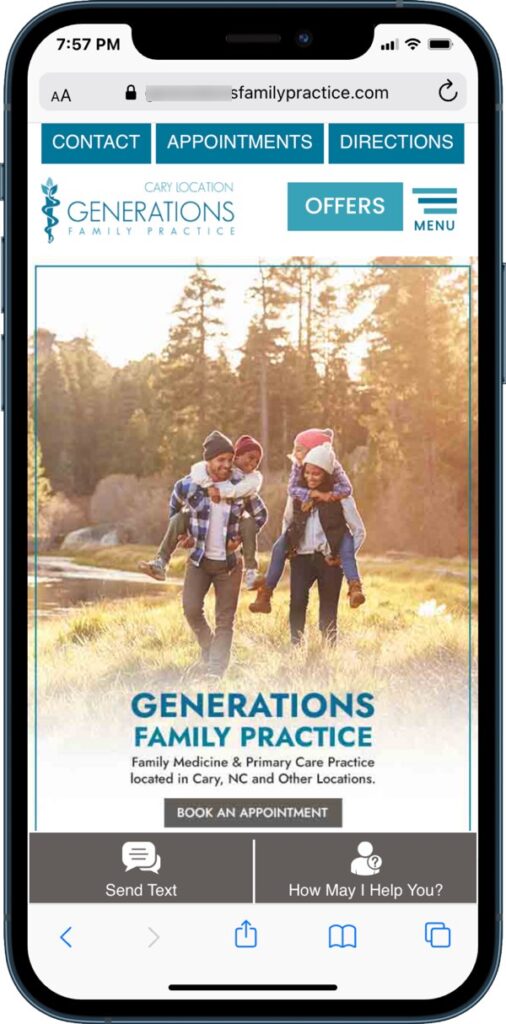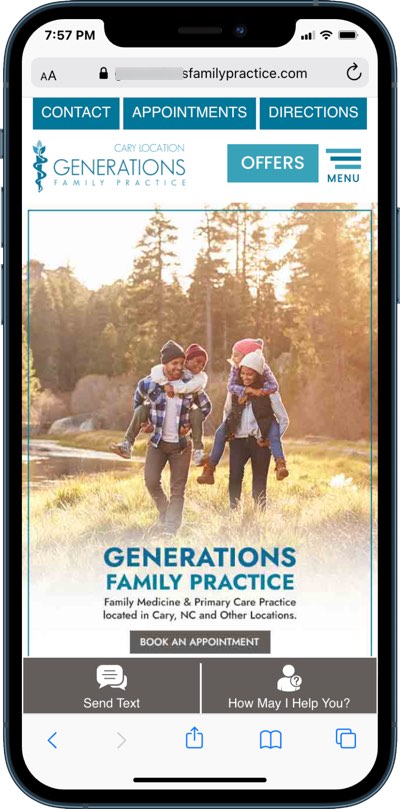How to Build the Brand of Your Healthcare Practice and Your Doctor / Dentist
Assuming you do not operate your medical practice in a rural area where you are the only doctor for miles and miles around, you are likely to have competitors. Depending on the healthcare services you are offering, there may be many competitors who are all after the same pool of patients. To stand out from the rest, you need to build a brand for your medical practice. Instead of blending in with the rest, you need to distinguish yourself from the rest of your colleagues. A way to effectively do this is to build a brand for your medical practice. See some examples of Medical Practice Branding.
Branding Rule No 1.
If You Build a Brand, Customers (Patients) Look For You.
If You Build a Website, You Look For Customers (Patients).
Note: We Always Focus On Building Your Brand.


How to Build the Brand of Your Healthcare Practice
Step 1. Establish A Brand Name, Slogan, and Logo
For your medical practice to stand out amongst your competitors, you need to establish a brand name for your business. It would help if you also had a slogan and a logo for it. Before you select a name, slogan, and logo, do some research of your competitors. You do not want to choose anything that can be confused for another business. Ensure that your brand name, slogan, and logo is unique. Anything similar can cause issues for your moving forward and may lead to some legal action. While less likely for independently owned businesses, if they are identical to a national brand, you can expect a letter asking you to change it. It can be costly to replace things if you have already invested in various marketing materials.
Once your brand name, slogan, and logo are selected, be sure to use it on all of your marketing materials. Anything associated with your business needs to have one, if not all, of these things. Avoid making regular changes to your name, slogan, and logo. You will notice that corporate brands will go years, if not decades, with the same logo and slogan. Once established with the public, it can be expensive to reeducate them to let them know to look for different names and symbols. If you lack artistic skills, hire a graphic designer to create a logo for you.
Step 2. Maintain The Voice Of Your Brand
When you establish the voice of your brand, maintain it all marketing efforts. A voice of a brand is the way you write and how you speak to your patients. Generally, this can be accomplished by having only one person write up emails, social media posts, or design marketing materials. You can be sure a voice is maintained with the same person handling all of these aspects of your marketing. However, that is not always possible if you select several people to handle your marketing or choose a medical marketing agency to take on the majority of your advertising efforts.
a) Consistency Across Branding – use the same images and messaging across all platforms
b) Reputation – Focus on getting positive reviews on Google
c) Clear Brand Message – Do not change the main message every month, or even every year
d) Visually Clean – Cluttered designs turn off potential patients
e) Recognizable & Memorable – Stick with something that is easy to remember, for example – “TikTok videos”
When it isn’t practical for one person to be the primary author of your marketing materials or if you higher an agency, create a document outlining the type of voice you want your marketing materials to have. Outline the terms you want to use, any slogans or phrases you like to use, and the general theme of how content should read. This guide will help others or the marketing agency maintain your brand.
Step 3. Use Branded Pictures
Whenever you use a picture for any marketing efforts (email, website, brochure), use branded images. What is a branded image? It is an image or photo that matches your brand. It uses updated logos, uniforms, colors, and anything else that makes your clinic unique. When possible, use unique pictures of your actual medical practice and the staff that work there. Real photographs are preferred over stock images. Many people can tell the difference between photos that are taken at an actual medical practice and stock images. If you do use stock images, do not take pictures from other websites or images off of the internet. You are likely violating copyright law if you use pictures without paying for them. While there are services out there that provide free stock images, you will probably have to pay for high-quality stock images. Regardless of whatever image you use, put your logo on it. This will help establish your brand and prevent others from using your photos for their commercial gain.
Step 4. Establish Brand Colors and Font For Marketing Materials
Selecting your brand colors and fonts is very important for your medical practice. The colors and font you choose should be consistent not only in the marketing materials you send out, but also match your medical practice. The colors inside your medical practice should be the same colors you use in your brochure. When you do pick your brand colors, establish which specific colors they are, and do not say things like “red” and “yellow.” Each color has many different shades, so establish which code to use to get the color you desire. Their “Hex Code” can describe colors, their RGB (Red, Green, Blue) or by their HSL (hue, saturation, lightness.) Write down these values and include them in any brand guides your marketers or marketing agency uses. The font used in your brochure should be the same font on your website. The font on your website should be uniform throughout. Do not use different fonts for different pages. It will make your medical practice’s website look very unprofessional.
When should I change my brand?
Generally, you should avoid changing your brand frequently. It should be reviewed every few years to make sure it does not look dated. For example, if the last time you checked your colors and fonts were the 1990’s, it may be time to update them. Try to review any branding standards at least every three or so years to make sure they still work for your medical practice. When you make any change, be sure to inform your patients to expect new colors, slogans, or logos. When you change anything, be sure to stick with it. Use any remaining marketing supplies you may have and be mindful not to reorder anything new with any old branding standards. Finally, watch for any new competitors that appear in your area to ensure they do not start using a brand that is similar to yours.
Branding is a great way to establish your medical practice in your community. Work to develop brand standards and make sure everyone follows them. You will build your brand and help increase your organic traffic!
How to Build the Brand of Your Healthcare Provider(s) and Doctors
When people think of the word “brand,” they generally associate the word with a big national company like Home Depot, Geico, or Nike. A brand typically has instantly recognizable logos, colors, and in some cases, a spokesperson. However, a brand can also be people. The Kardashian family is a brand, and although not as prominent today, even Paris Hilton could be considered a brand. A brand can be many things, but a brand is a specific identity or image of something at its core. There can be good brands known for their quality and inferior brands known for their defective products.
A doctor can, with some work, brand themselves and become a brand themselves. Not all doctors can become their brand. Generally, if a doctor works for a large organization or another doctor, there will be limited opportunities to brand themselves. These businesses do not want a doctor to build a large following and then take them away if they decide to open a practice. However, if a doctor opens their practice and is the “face” of the business, branding themselves can be a valuable and worthwhile marketing tactic.
What are things a doctor should consider when creating their brand?
- Know your strengths and weaknesses – When developing a brand, write down a list of things you do very well and do poorly. For example, are you a good public speaker? Can you think on your feet? Do you easily explain complicated medical ideas to people who have not had medical training? When treating patients, do you have a knack for diagnosing sports injuries? Writing these down will help you begin to develop a brand that highlights things that you are great at.
- What do you offer that other doctors do not? – Once you have a good list of things you do well, it is time to compare them to competitors in your community. Generally speaking, doctors are going to have a lot of overlapping skills that they are skilled at. For the brand of a doctor to rise above others, it needs to highlight skills and services that are not widely available. For example, if you are a concussions specialist who often treats student-athletes, that can be powerful thing to use as a brand.
- What could you be considered an expert at? – Being an expert at something is a very marketable quality to have. It may be something related in the field of medicine your practice, like sports injuries. However, it does not always have to be medicine-related. For example, a doctor’s expert ability to create and give detailed presentations would be a valuable thing to market and contribute to their “brand.”
- What is your target audience? – When developing a brand, the audience a doctor aims to get noticed by is very important. Some choices may be different depending on the target audience selected. For example, if a doctor specializes in senior care, they will want to use many pictures where it looks like the doctor and staff are taking time to listen to the concerns of their older patients. This resonates deeply with older demographics. For those with young children, photos of happy children getting immunization shots or band-aids would likely be pictured. Knowing the audience allows a doctor to present the most attractive brand for their target audience to consider for their healthcare choices.
- Stay on-brand with marketing campaigns – Once a brand is decided on and locked in, a doctor needs to stay on brand. This is especially true when it comes to doctors posting on social media about their private lives. When a doctor brands themselves, they need to be mindful what other information they are putting out there. For example, if a doctor is a concussion specialist, posting pictures of them bike riding without a helmet will hurt their brand about helping people prevent concussions. Doctors need to remain consistent and on topic about what they put out over the internet. Consider creating private social media accounts to avoid these situations.
- Commit to a brand and put time into it – Creating a brand is not something that can be done overnight or can be easily accomplished. It requires constant work and effort to build it slowly. There will be some great opportunities and occasionally some setbacks. However, a brand will never be created if a doctor does not put the time into it to develop it.
What are some excellent ways for a doctor to create a brand for themselves?
If a doctor wants to create a brand around themself, there are several marketing tactics they can use. While most are online and digital marketing strategies, some offline and traditional strategies may work very well. These marketing strategies include:
- Writing a blog
- Posting on social media
- Writing in local publications
- TV and radio interviews
How can writing content based on procedures help brand a doctor?
A content page is a great way to brand a doctor for many reasons. First and foremost, it is a doctor’s opportunity to showcase their skills and knowledge. Writing allows a reader, be it a patient or a potential patient, to get a good picture of what a doctor brings to the table. A blog posting allows a doctor to select a topic and go into depth on it. This topic should be related to one of their strengths, a local health concern, or some tips to help patients stay healthy. While helpful, the topic of a blog post does not necessarily have to be related to an area a doctor specializes in. This is especially true when it comes to a local health concern. For example, it would be perfectly acceptable as a sports injury doctor to have written a post about COVID-19 safety protocols. Later, that same doctor could write about staying safe while engaging in outdoor activities to prevent sprains and strains. A blog also allows their personality to come through and be seen by a community.
Blogs are also advantageous from a content marketing and search engine optimization perspective. For content marketing, blogs allow doctors to add unique, authoritative, and helpful information to their websites. A search engine will respond well to that, and if a blog is popular enough, it may even start to get an organic ranking. If blog posts a doctor writes get local and national organic rankings, that will go a long way towards building that doctor’s brand. Content marketing using blogs is a typical digital marketing tactic that has proven to be very effective. Blog posts fit perfectly into that strategy. When writing a blog, a doctor should consult their SEO keyword list to include them in the content, if applicable. Ensuring the keywords used throughout a website’s content are also used in the blog will help increase its value.
Doctors should be careful how much time they want to commit to writing a blog post. While writing something once a week may sound relatively straightforward, writing, proofreading, and post material can be time-consuming. Also, having a weekly posting schedule means you need 52 things to talk about a year. It does not look good, from a branding perspective, to have eight weeks of monthly blog posts and then one blog post once every two months. Many doctors do a monthly posting schedule. When posted, this blog post can then be shared via email marketing, social media posting, and, in some cases, even using text message marketing.
How can the use of Social Media help brand a doctor?
Social media is a powerful tool to brand a doctor. It is often the best way to connect with groups of people or even one on one to push a doctor’s brand. When considering social media to brand a doctor, be mindful of the social media channels already established for a medical practice. Some doctors maintain separate channels for their medical practice and their brand. Others will use their brand as the leading social media channel for their medical practice. Ultimately, this boils down to what works best for their situation. If a medical practice has a dedicated social media person and the doctor has time to do their own social media posts, keeping these separate makes sense. Also, if a doctor that already has a following gets hired by a larger organization, it is beneficial to keep these separate so both entities can repost each other. For doctors running a small practice and trying to brand themselves, having one set of accounts is usually easier.
The social media channels a doctor trying to brand themselves should be using included:
- Twitter / X – Used for short messages, announcements, and thoughts throughout the day. Posts can also include links, pictures, and short videos.
- Facebook – For longer posts featuring more text. Can also post links, videos, pictures, events, and fundraisers.
- Instagram – All posts must have a video or picture associated with them. Great visual medium to showcase a facility or the activities of a doctor.
These three social media channels also have two features that many doctors find helpful. First, each has a live streaming feature. Here, a doctor can go on and broadcast live to their audience. Many use this for Q&A sessions or to give a small presentation about a subject. Some will go live randomly, while others will promote a schedule when they Livestream. Second, each of these channels can give the ability for people to message them privately. Some doctors turn this on while others do not. HIPAA privacy and security considerations must be kept in mind when personally communicating with others. Otherwise, a doctor may accidentally violate HIPAA rules.
How can a doctor brand themselves use traditional marketing or offline strategies?
While not a prominent as it once was, traditional marketing can be powerful in promoting the brand of a doctor. These strategies can reach a large audience but must be paired with a digital aspect, like sending patients to a website to be truly effective. Below are two traditional marketing approaches to promote the brand of a doctor:
Writing In Local Newspapers or Publications
A doctor looking to build their brand should approach a local newspaper to write a column about a health topic. This column is not meant to promote their practice but rather to showcase their expertise about a topic. Despite not promoting a medical practice, the column will give a short bio about the doctor who writes the column and will often provide a link for people to explore. As a bonus, the online version of a column will have a hyperlink, contributing to the SEO value of their website. Convincing a newspaper to give a doctor some space to write something can be tricky. Room in a physical newspaper is often limited, so the topic a doctor offers to write about must be relevant and valuable to the paper’s readers. There is often a character limit the doctor must abide by to be published. Prominent national newspapers usually only publish columns from doctors that are nationally known. Regional newspapers may be easier to get published in, but they also trend towards doctors who already have brands. When starting to create a brand, a doctor should approach smaller newspapers or community newspapers to write a column. Once a doctor has been published a few times, they can then take those articles and show regional newspapers the type of column they write. This will give them a better chance to be published.
Appearing on Local Radio or TV
Amongst the most challenging traditional media outlets to appear on, radio and television require a lot of work and patience. Radio stations and news stations are bombarded every day by hundreds of people wanting them to do news stories or offering their expertise to get some coverage. As a doctor, you will need to make yourself stand out amidst all of these pitches. A doctor should highlight their strengths and what makes them unique compared to other doctors in the area. Avoid contacting a station every day of the week, or your request will quickly find its way into a spam folder. However, follow up regularly and remind them of the value of your expertise and how it could be used to enhance a news story.
When pursuing the goal of getting on TV or the radio, keep in mind that these opportunities come quickly. A television or radio station may call in the morning hoping to talk to you in the afternoon so that a story can make the evening news. If a doctor is unavailable, they will move on to the next person on their list, and a doctor now has missed the opportunity. A doctor should always be prepared to give an interview or offer their expertise to a news outlet. They should always have a branded shirt, hat, or lab coat available for pictures or videos.
If a doctor does manage to get on TV or onto the radio, ask the station for a copy of the segment or where the feature is published. This media can then be embedded onto a website for additional SEO and content value. Plus, it can also be used in social media posts or email marketing campaigns.
The branding of a doctor is not an easy task, but it can have significant long-term benefits. The experts at PatientGain.com have worked with many doctors to fine-tune their branding and reach a larger target audience. Call our team today and let us start to help you with your branding!


